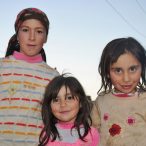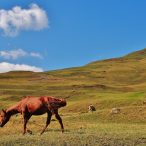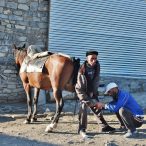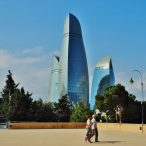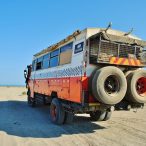Azerbaijan
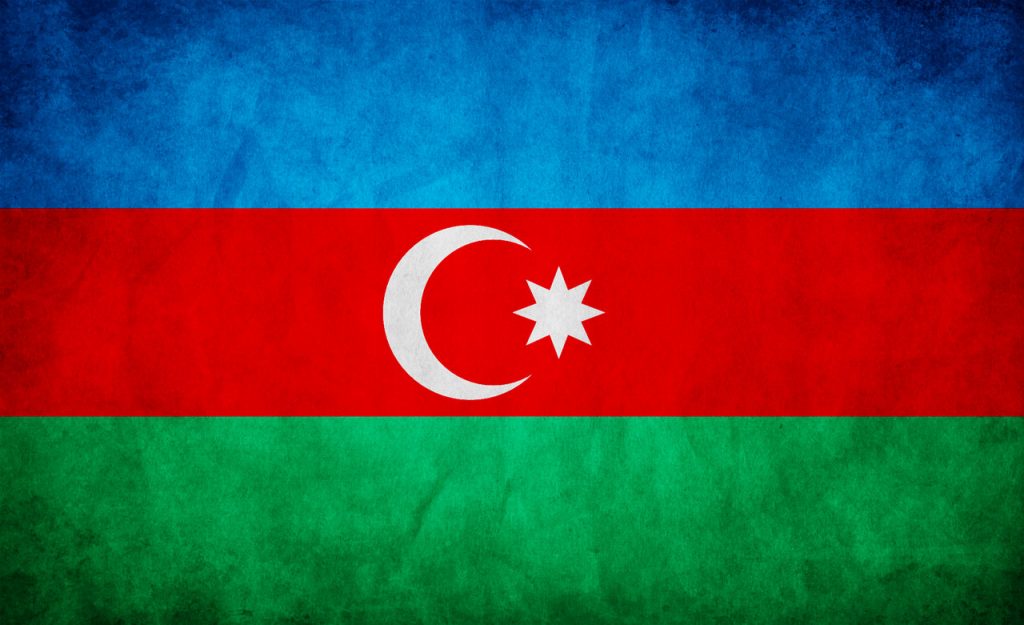
Official name: Republic of Azerbaijan
Population: 9 900 000 m
Area: 86 600 km²
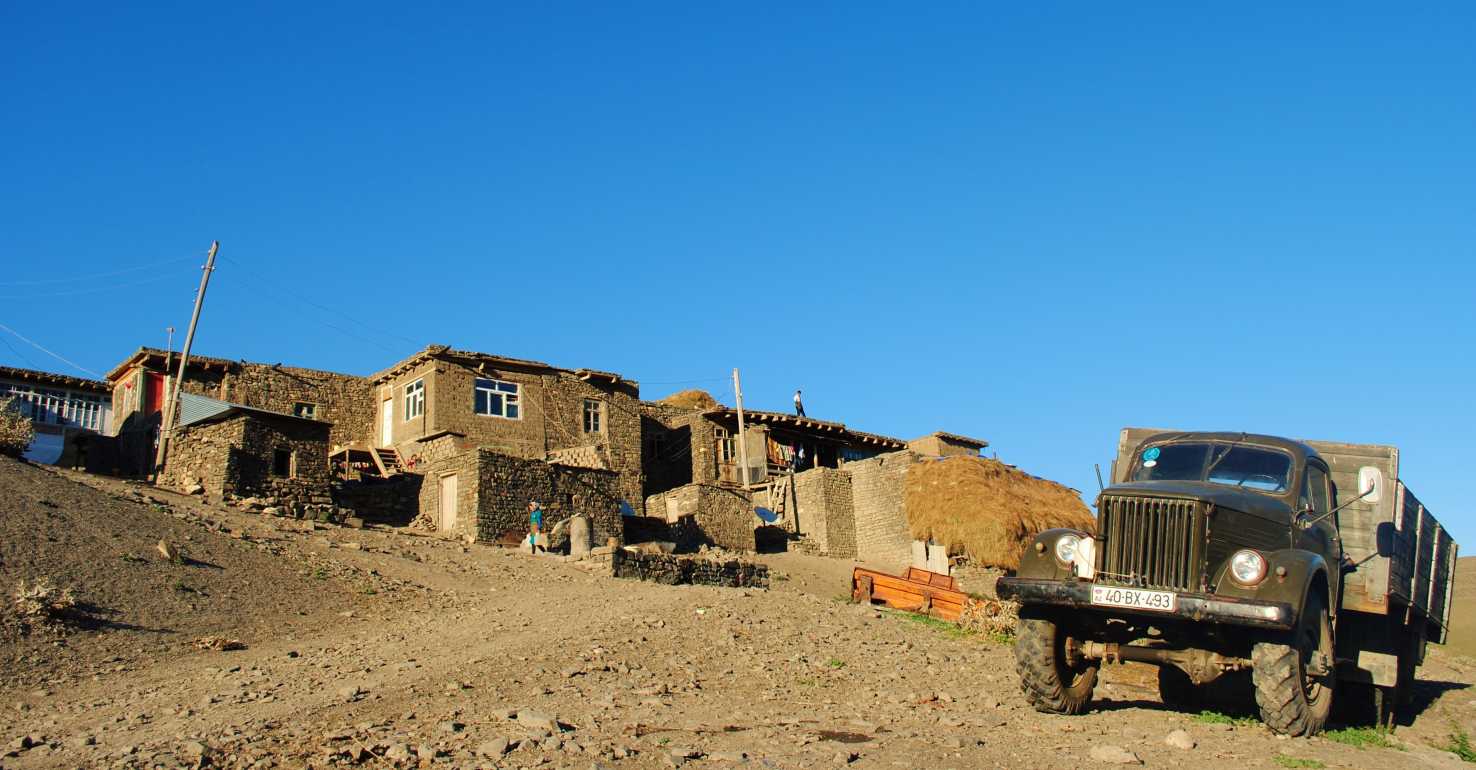
Gallery
Tourist attractions of Azerbaijan, Azerbaijan – the present times, history of Azerbaijan.
Tourist attractions of Azerbaijan
Azerbaijan is famous for its bureaucracy and expensive, difficult to obtain visas what in my point of view means a great loss to both tourists and Azeris. To me Azerbaijan is a small Turkey, with Turkish style tea cups, with nice views, interesting architecture and handicrafts, and also with a strong dictatorship. My time spent in Azerbaijan was also a good lesson about Azeris’ opinion on Armenia and Nagorno-Karabakh. There is definitely a great hatred to the neighbours but I don’t judge them and I think I`ll leave this problem to them. In Azerbaijan people were also welcoming and eager to talk and the food was quite good, although they could give more meat to kebabs and not just a big bun. I also liked the capital of Baku where I could clearly see that the government invested a lot of money. I felt that my presence itself in Azerbaijan was a great adventure, although there were also mountains, rivers and waterfalls.
My favourite place was a remote hill station of Xinaliq. It was founded 5000 years ago, which at the same time is the highest altitude village in Azerbaijan. I saw traditional houses made of stones and traditional shepherd life of Azerbaijan. When I was in Seki I saw traditional caravanserai which today serve as hotels, shops, palaces and museum and in a small mountain village of Lahic I admired beautiful canyon and saw coppersmiths making dishes by hands. I also found the capital city of Baku very appealing. In my point of view it was a mixture of history with modern life for a lot of money. From Baku I went for a trip to Qobustan and from there to see the petroglyphs, the thousands year old paintings carved on rocks. Then I saw mud volcanoes which I found even more interesting. In the outskirts of Baku there is also Atesgah – Fire Temple, which I warmly recommend. For the end I also swam in the very calm Caspian Sea which unfortunately stank slightly with oil.
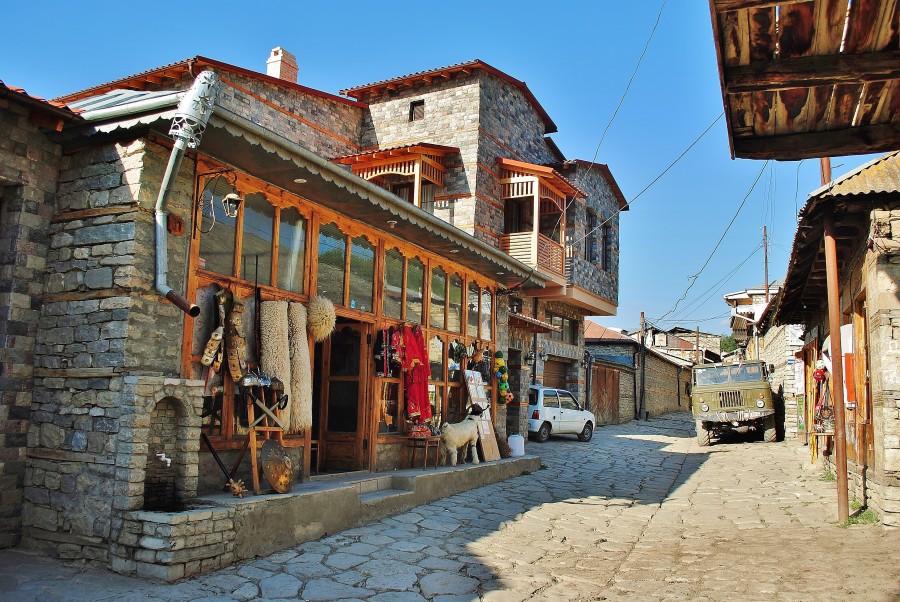
The people of Azerbaijan are helpful and curious of tourists although there were also surprised by my presence because tourism there is limited. I can’t say a single bad word about them. On the other hand Azerbaijanis prefer not to talk too much and didn’t trust me in the conversation because “they didn’t know who I was and for whom I worked.” They also didn’t react very well when they saw my camera because they were raised in the company of the KGB what brings bad memories. As a rule they prefer to not to touch the subject of the conflict with the hated Armenia because they don’t want to get upset. Sometimes however it happens that they open. According to Azerbaijanis taking over Karabakh and sending their army to Yerevan would be very easy but Russia would not allow them to do that.
Azerbaijan – the present times
Economy
Azerbaijan is the most dynamic economy in the South Caucasus, mainly because it is an economy based on the extraction of oil. The culmination of the mining industry was the completion of the oil channel from Baku through Tbilisi to eastern Turkey. Oil in Azerbaijan is so important that in 2005-2007 GDP of the country was at 26.4 % to 41.7 %. Between 2008 and 2009 GDP was only in the range of 9% -10 %, while in 2001 economic growth was only 0.1 % level since oil production for some time was satisfied. In 2012 during the economic growth (of course related to oil) reached 40 %, but later because of the economic crisis Azerbaijan tries the economy to be more diverse. Azerbaijan also plans gas exports and the development of the energy industry, but corruption, bureaucracy and the conflict with Armenia poses many obstacles. Another important part of the economy is agriculture which occupies about 38.3 % of the population. The most popular crops of Azerbaijan are cotton, seeds, rice, fruits and vegetables, tea and tobacco. Shepherds also breed sheep, goats, pigs and cows. Despite the Azeri economy is based on oil and it plans to develop the gas and energy industries the additional part of economy is the chemical industry, steel, textiles, cement, iron ore and production of equipment for oil extraction. It was calculated that foreign companies invested about $60bn in the Azeri industry. Some time fishery was very popular, but today beluga and sturgeon which are caught mainly for caviar are smaller in numbers in the Caspian Sea. In addition the Azerbaijani economy is still in a process of transformation from centrally controlled to a free market economy where privatization process is too slow. The banking sector is still developing and it is not a large part of the Azerbaijani economy. Unemployment in 2012 was only 1 %, which is a great achievement comparing to other countries of the Caucasus and many European Union countries. However the unemployment rate for the 15-24 age groups is already 14.4 %. As an eyewitness I can say that Azerbaijan is developing fast and the centre of Baku looks like a monument of money, which is not an equivalent of the rest of the country and it happens at the expense of the poor population. A bus driver in Baku told me that in such an expensive city like Baku he earned only 150 manat and he had no idea how to survive.
Edukacja
Education in Azerbaijan is compulsory and free for all between the ages of 6 to 17 years. The compulsory language at a primary and secondary level is Azeri, but later in colleges Russian is also often Russian. Education in Azerbaijan is therefore at a good level and Baku has many universities with profiles such as: economics, technical and medical studies. Besides, there are many scientific journals published in Azeri, Russian and several Western languages. One of the major problems is the fact that education is the best developed only in Baku and in small villages and especially in the mountainous areas there is lack scientific tools and educated is neglected. In the economy section I wrote a few good things about Azerbaijan, but I never said that the money earned by the Azerbaijani government translate into human welfare. Because of poverty in many parts of Azerbaijani women get married very early and many of them leave school. During the Soviet times presence in schools was mandatory for both sexes, but after achieving independence in 1991 education especially among girls began to decline. I also want to add that although Azerbaijan is an Islamic country which I would describe as quite easy going, in the pre-Soviet era education focused on Islam and in the post-Soviet era the country was the centre of Islamic education despite the nation’s coldness to the religion. Literacy in Azerbaijan stands at good 99.8 %.
Health
During the Soviet times medical care was free and easily accessible, even though it was one of the worst of all republics. However after achieving independence in 1991 the health system in Azerbaijan got destroyed. Healthcare began operating on the basis of bribes, location and the social status of a patient. Another words health care is for those are able to pay for it and sometimes it costs more than a monthly salary. Those who are too poor are forced to go to a state hospital and then exit with more disease when they first came in. In the constitution of Azerbaijan it is written that the state is responsible for the treatment of its people without financial gains, but in practice this is pure fantasy. On one hand the health system is free and on the other people have to pay a lot of money even for a blood check. Old pensioners are in the worst situation. They have a choice to either pay their entire pension for medical appointment and then die of starvation, or eat and keep their fingers crossed that they would not die. Hospitals lack equipment and sanitation, and doctors and nurses earns not enough to care for the sick and they are not sufficiently trained. The worst scenario is of course in rural areas where there is sometimes lack of water and electricity. Azerbaijani government spends on health care around 2% of its GDP because part of it was privatized what still does not serve the majority of citizens. The Every year the government of Azerbaijan spends hundreds of millions of dollars on health care, on medications and equipment imported from abroad, but in practice as many as 62 % of the total costs are spent from the pockets of patients and for serious operations Azeris go to Turkey and Iran. The problem is in the lack of money.

Azerbaijan is a country with a low risk in terms of HIV / AIDS but the epidemic is increasing especially in Baku among young people and among people of the highest risk (drug addicts, homosexuals). In 2007 about 1,300 people were infected and among them foreigners working in Azerbaijan. It is suspected that the true number of infected is much higher because many people are not examined due to fear of rejection from the society. HIV in Azerbaijan often goes hand in hand with hepatitis, syphilis and tuberculosis. In Azerbaijan in some areas there is also seasonal malaria but it is still a low-risk country.
Culture/Religion
Geographical location of Azerbaijan and rich but rarely enjoyable history meant that the country has a diverse culture. Azerbaijan is located in Western Asia, close to Europe, and is bordered with stronger from itself countries such as Turkey and Iran. Azerbaijan was also one of the post-Soviet republics and today like the rest of the world is a victim of globalization. All of these factors, the culture and the ethnic composition of Azerbaijan are very diverse.
Although Azerbaijan is a society inhabited by about 90 % Azerbaijanis, there are also Armenians, Russians and others. Azerbaijani language belongs to the Turkic language and the language spoken as the first by approximately 82 % of the population. In addition 38% speaks fluent Russian and many universities also teach in that language. I witnessed a Turk and an Azeri talking to each other in their native languages and they understood each other without a problem. When it comes to religions Azerbaijan is definitely an Islamic country because about 99 % are Muslims. These are mainly Shia (about 70%) and Sunni (about 30%), although the version of Islam in Azerbaijan is very mild and has only a cultural significance. We can definitely say that radical Islamic movements enjoy very little popularity. This is proved by numerous theatres and discos where women dress in a European style. There are also Jews, mainly in mountainous areas and in Baku and a small number of Christians.
The main part of the society is a family and it is a habit in Azerbaijan that several generations live together, and it is especially popular outside of Baku. Architecture of Azerbaijan is a combination of East and West. Historic objects such as Defense Walls in Baku are of a Turkish origin and even the film studio has a gate with a distinctive Islamic arc which I’ve seen before in Uzbekistan. As it is in the case of Uzbekistan, in the later years Azerbaijan also suffered because of the Soviet architecture what means massive walls designed on defense shelters. Another important element of the Azerbaijani culture is the food, which in spite of its rich cuisine of neighbouring nations like Iran and Turkey has its characteristic components. Azerbaijan is also famous for some of the best apricots in the world and a festival of juicy pomegranate I also held over there. Of course Azerbaijan also has its art, theatre and literature, national dance, national costumes and festivals associated with the traditional outfits. Especially when it comes to music and dance forms the Azerbaijani culture is very rich, but I’m guessing that a dance in discos is better known than the national dance. Azerbaijan can be also proud because of its craft, as well as its jewelry, sculpting in wood, metal, bone and stone and it is famous fro embroidery. I think however that the most profound cultural background is in hand made carpets as it can be easily guessed because Azerbaijan has in the south the country of Sinbad and Aladdin and in the west they have Ottomans able to look only at Europe. Each region of Azerbaijan has its traditional pattern and its own colours. The mere sale of carpets in the bazaars is also rooted in the culture as it is accompanied by the sale of goats, pottery and eating traditional dishes. Given their experience this practice can be applied to all the countries of Central Asia, Iran and Turkey. Selling carpets in the markets is also deeply rooted in its culture and it is connected with selling goats, pottery and traditional foods. Based on my experiences I can say that this habit also exists in all countries of Central Asia, Iran and Turkey.
Media
Freedom of speech and press in Azerbaijan does not exist. Journalists live under heavy pressure of the government and they are regularly blackmailed and threatened and it also happened a few times that they were imprisoned and murdered. Internet is the only free medium but only on the first look because the government hackers have broken into many news websites. Generally everybody who criticizes the government, Islam or even the Iranian government has to prepare for long prison sentences or living in a constant fear.
In the press freedom index in 2013, on 179 countries and territories Azerbaijan takes a very bad, enslaved 156th place.

Press freedom says a lot about the country although it is a subject which nobody likes to discuss. For a comparison the extreme far Left Britain is on the 29th place, behind such Third World countries as Namibia or Jamaica. Interesting, isn’t it?
Environmental issues
The natural environment of Azerbaijan in seriously threatened. Soil has been polluted by pesticides and other toxic substances because of cotton production in the times of the Soviet Union. Besides that the petrochemical industry and oil seriously polluted water and air in the Caspian Sea region. There are a few environmental organizations but because of low funding clearing the damages is very slow. Over fishing is also a big problem what resulted in decreasing populations of beluga and sturgeon, which are the main sources of world supply in caviar.
In 2007 a city of Sumgayit was on the list of the 10 most polluted cities in the world, and the capital city of Baku until 2010 was the lowest ranked city when it comes to health and hygiene. Among many of the Azerbaijan’s ecological problems there such as: Shrinking of forests and fauna and flora, drinking water supply in water which is not suitable to drink, oil degradation, erosion and desertification of the country, toxic chemical wastes, additional air pollution from industries and vehicles. In Azerbaijan all those problems are ignored and treated as the last of the priorities.
History of Azerbaijan
Azerbaijan lies on a territory which was fought for many empires and that’s why a map of this country or rather its cultural circle has changed many times. The culture of Azeri people comes from the territories of what is today North West Iran, from such cities as Ardabil and Tabriz. For many centuries Azerbaijan was attacked by Turks, Persians, Arabs and Russians. Today the ethnic background of Azeris is a mixture of all of them, the same as the language, culture and adopted later Islam. According to me however Azerbaijan is culturally the closest to Turkey.
From about IV century B.C. Azerbaijan used to be a part of the Roman Empire and its main religion was Zoroastrianism, and that area was called Caucasian Albania (there is no connection with today Balkan country). Then in 325 Albanians adopted Christianity and they built a lot of churches. However for current Azeris it is of great importance that they were Albanians and not Armenians, what is their moral reason to control Karabakh and many other parts. Islam became the main religion in the VII century after Arab and Turkish invasions, and that’s why until today most Azeris are racially closest to the Turks. Christians from those areas survived only in the mountains. Islam has it bloom in the Caucasus in the XII century and during that time most cities were built. In XIII century Mongols turned everything into dust and the rest of destruction followed with earthquakes. Then rebuilding of those cities took Azeris two centuries. XVI century was terrible for Azerbaijan because of constant battles between the Persian Empire and the Ottoman Empire. In XVIII century the Persian Empire started falling and that’s a few independent khanates were formed in he territory of Azerbaijan. When Persia grew into strength again it asked the Russian empire for help in uniting the khanates but as a result it lost most of them for Russia. To strengthen its domination after defeating Persia, Russia started inviting Christians to move to khanates what resulted in fights on ethnic and cultural background, which took place in 1905, 1908 and 1989. In 1970s Baku became a centre of oil extraction and to 1905 it supplied half of the world in oil. This was the moment of the birth of evil in the form of Stalin who used the bad situation of workers for his own political gains.
In 1917 Russian czarism was ended and in 1918 Azerbaijan was pronounced a Democratic Republic, even though that Baku was under the Bolshevik control, but only to the times when they were thrown away by the Turkish army. In 1920 the Bolshevik Red Army invaded again and founded the Transcaucasian Socialist Republic in 1922. During that time Azerbaijan lost a lot of territories what in result Naxcivan was separated from the rest of the country, and then Stalin ordered to murder and sent to concentration camps hundreds of thousands of Azeris. During WW2 Hitler also wanted to control Baku to supply Germany in energy. In 1980 serious clashes started on ethnic grounds between Azeris and Armenians what was just a start of the Nagorno Karabakh conflict. As a result in 1990 Russia attacked its then Azeri republic and killed a lot of civilians, what resulted in the public opinion to turn away from Russia and in 1991 Azerbaijan announced its independence from the Soviet Union.

Then after a few quick presidential changes Heydar Aliyev came to power, who signed a ceasefire with Armenia and Nagorno Karabakh. However, 13% of the Azeri territory was under Armenian control what made 800.000 Azeris homeless and a whole generation of children was without education. The defeat of Azerbaijan was in Karabakh was a great shame and accepting refugees would have been a fatal admission to that defeat, and another attack would have stopped the economic progress. Despite independence Azerbaijan started difficult times.
Travel reports
Map
Location
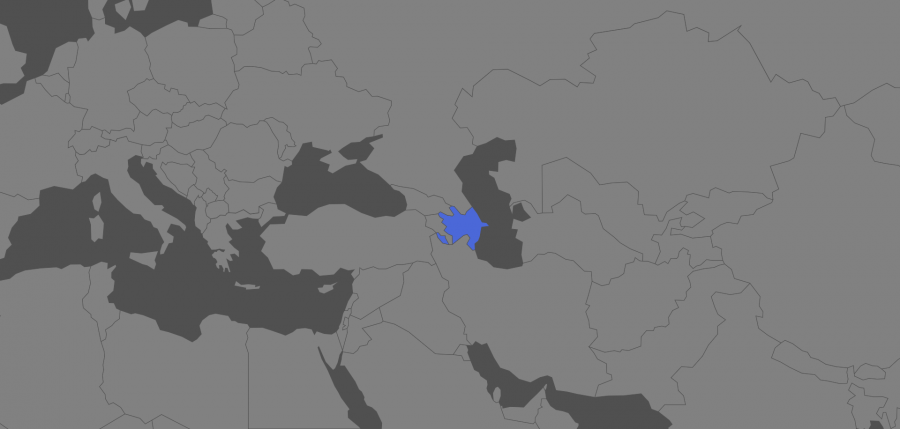
Practical information
Tourist visa: In 2017 Azerbaijan eased its very strict visa law, which I experienced in 2013, when I traveled around the country. In 2017 Azerbaijan introduced an electronic visa, which can be applied on the government website www.evisa.gov.az. Tourist visa is issued for 30 days, it costs $23, and decision is made within 3 days. Tourists who are in a hurry can apply for a visa in a super-fast mode, for $53. Then the decision is made within 3 hours. Most Europeans, who want to stay on the territory of Azerbaijan for more than 15 days, have a registration obligation, which can be arranged at www.migration.gov.az. One can also appear in the registration office in Baku. Registration is free.
It is worth mentioning that the Nagorno-Karabakh region is in the territory of Azerbaijan, but it is under the control of Armenia, and that’s why visa requirements over there are different. I wrote about it on https://www.compasstravelguide.net/countries/nagorno-karabakh/. Due to the difficult situation between Azerbaijan and Armenia, there are no air connections between these countries, no telephone connections or postal exchange. It is also very important to not to have an Armenian stamp, because this also makes the chance of getting Azeri visa very slim. However, the thing which completely disqualifies from getting an Azeri visa is a visa of the Nagorno Karabakh Republic, because according to the government of Azerbaijan, everybody who has been to Karabakh entered Azerbaijan illegally. Those travellers who would like to visit all countries of the Caucasus region should first go to Georgia, then to Azerbaijan, and then through Georgia to Armenia, and at the very end to Karabakh. That’s what I did, and this is what I advise to future travelers.
Nevertheless, I would like to tell about the bureaucracy that I experienced in 2013, so my readers could appreciate that things are moving forward. In 2013 travelling around Azerbaijan started before entering the country because the visa requirements were very expensive, difficult and extremely bureaucratic. In order to enter Azerbaijan first I must have paid for an invitation from an institution in Azerbaijan, and usually it was a travel agency in Baku. Then with the invitation and a filled application travellers had to join a very long queue outside the Azeri embassy. Visa cost about 80 euros and an invitation about 20 euros, and there still wasn’t any guarantee that even after paying that amount and fulfilling all the conditions we would have got the visa. I heard about Spanish and Swedish people who paid 120 euros each, and they still didn’t get their visas.
I got my visa in Tbilisi I managed to get it through a travel agency located just few metres away from the consulate of Azerbaijan. That agency also organized invitations through an office in Baku. An office worker checked first if I had already been to Armenia and Karabakh, and because I hadn’t, for a 30 day one entry visa I paid 80 euros, which was the most expensive one of all. My visa was ready within 3 days and I think that at that time it was the best way of getting the Azeri visa.
Alternatively there is also an option of getting a visa in Batumi, and during the time when I was in Georgia in the Batumi consulate invitation was not required and a visa cost only 50 euros. The consulate of Azerbaijan in Batumi has been always the best option, without stupid question or bureaucracy, although this should be checked frequently as the rules in Azerbaijan change quickly and unexpectedly. I think that is an important information for citizens who are not covered by an electronic visa, because old rules are still in force for many.
Safety: Azerbaijan is a safe country for tourists. I spent in this country 10 days, I travelled by hitchhiking and a local transport, I slept in a tent in the mountains and I also went to Baku, and I never had any problems. Azeri people like all other people of Caucasus are always eager to talk and are always friendly to tourists.
Moving around the country: There is a well organized network of minibuses (marshrutka) although there also more expensive taxis and great hitchhiking opportunities where minibuses do not get. A big part of Azerbaijan I crossed by hitchhiking which enriches travellers in a more adventurous way.
Prices: (in 2013 when £1 = 1.3AZN) although when it come exchange the easiest option to remember is that 1 manat equals almost 1 euro. This means that Azerbaijan is an expensive country although based on my experience it is possible to travel cheaper. For the cheapest hotel in Baku I paid 10 manat even though other ones in the centre cost 40 or 50. For meals I paid about 2-4 manat and for tea 300 qepik and for ice cream 100 qepik. For a bus from Quba to Baku so for about 3 hour drive through half of the country I paid 4 manat. I also hitchhiked through many parts of Azerbaijan but there also certain regions where there is a need for taxis because there either no road or there isn’t a local transport to that place. This happened to me when I organized a trip from Qobustan to petro glyphs and then to the mud volcanoes what cost me 15 manat although the driver wanted 25 and for a 40km drive from Quba to Xinaliq the driver wanted 40 manat but I managed to pay only 20. On the way back I paid only 5 manat because I hitched from the road and I gave the driver for petrol. You always have to bargain.
Climate: There are few kinds of climate in Azerbaijan. In central and eastern Azerbaijan there is a subtropical and dry climate, and in the south eastern part it is a subtropical and dry. There is also a temperate climate by the Caspian Sea and cold in the higher parts of the mountains. Generally the best time to visit Azerbaijan is a time from April to October when days are warm and temperatures are from 21°C to 30°C, and in the summer months it even reaches 38°C. I don’t advice going in the winter when temperatures in Baku drop below zero, and it is freezing in the mountains.



